I'm going to break down key things that resulted in a successful completion of The Beast of the East on my first attempt - and my first successful 100 on my own horse my first time around! The post will be a bit of "worked/didn't work", but it will also be a more thorough analysis/narration of the things I did to best guarantee my success before luck and fate were factored into the equation.
Additionally, I'm going to share the statistics on this ride's loops based on my personal GPS and the mapping efforts I put forth prior to attending the ride.
Researching the trail and mapping
I think one of the biggest things that helped me find success with this this ride was the level of research I did on the trail. In addition to being a biologist, I also have a degree in geographic information systems (GIS) and am skilled with ArcGIS mapping programs in addition to Google Earth.Daryl had told me that if I could do No Frills and complete the OD 50, I could absolutely do the 100. He said that the other two rides covered the majority of the trails I'd be on for the 100 and mentioned that there wasn't anything else of major consequence in between that I hadn't seen. He also noted that the second half of the 100 was really easy compared to the first half.
In all of these points, he was 110% correct.
However, me being me, I had to get my grubby little hands on a map of the course and do my own research to confirm his claims. I blame my perpetual inner scientist for my skepticism and need to gain my own data as this wasn't exactly the kind of thing I could look up multiple peer-reviewed articles on. ;-)
I dug up a copy of the 100 mile trail from 2011 as a starting point and set to re-mapping the trail by hand within ArcMap. To aid in this effort, I added datasets from the Forest Service (FS) of trails and roads* to my map along with aerial and topographic basemaps.
*Roads are not necessarily defined as roads you or I can drive on within FS lands. These vary from fire roads to paved roads and may sometimes even include abandoned roads that are very overgrown. From my experience, the only road-like feature in common with all of the roads in this dataset is that all are wide enough to be traveled by a 4 wheeled vehicle. They are wider trails that most often include easier footing than single track, but they may not be entirely devoid of rocks.
In addition to the above layers, I also added my GPS tracks from the OD 50 in 2014 and No Frills in 2014 and 2016.
With these layers added to the map and the original hardcopy map in hand, I was able to figure out 95% of the trail and map it by hand in Arc. The 5% I couldn't map (and it is actually mapped, but I had to eyeball it vs. using known trail/road layers) was a short section or two of trail that is likely either unofficial FS trail, brand new FS trail (unlikely), or a handcut section of trail used just by the OD but not mapped for other trail use on the forest.
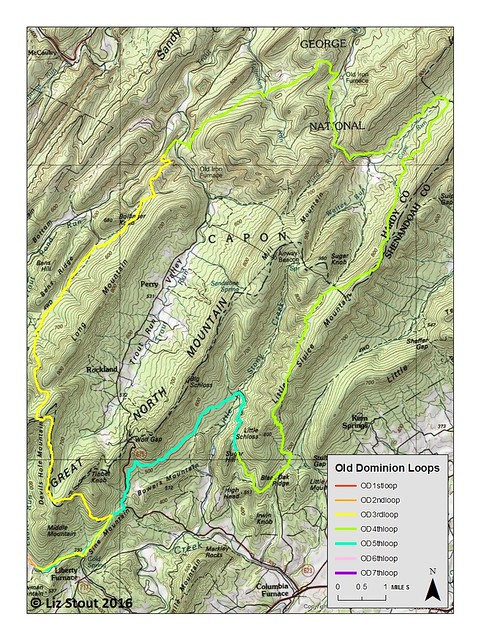 |
| Northern part of the course |
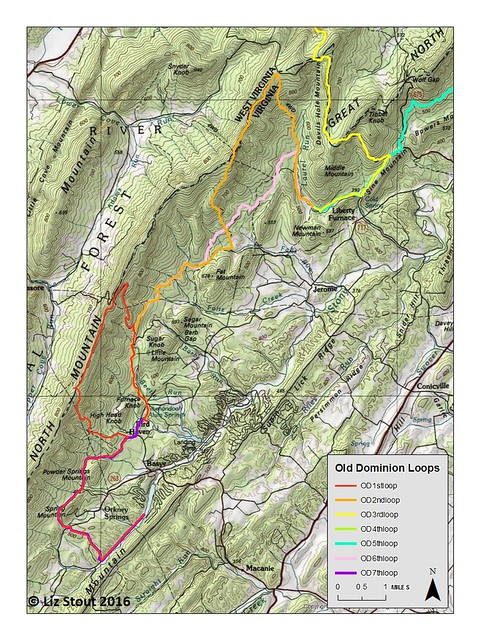 |
| Southern part of the course |
And because mapping it on the computer wasn't enough, I also went to efforts to obtain all of the hardcopy topographic quads that the course is within and drew out the course by hand on those. I then took what had become quite a giant map and tacked it up on a wall in my apartment so I could stare at it through the winter months while I was on my bike trainer and doing piyo to keep fit. Nothing is more motivating than wanting to conquer the unknown of a hard-as-hell 100 mile trail to get you working out!
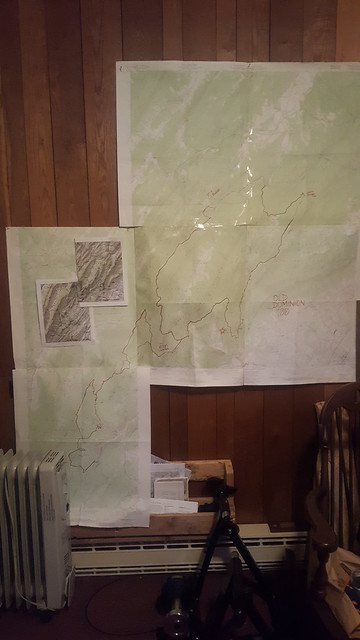 |
| Maybe a little overboard, but I love maps! |
Putting Number Estimates to the Mapped Trail
Once I had a successfully mapped route on my mapping programs, I assessed the individual loops to identify their individual length, where significant climbs were, how much climbing would occur on each significant climb (vertical feet gained), and also to note how much single track vs. road the loop contained. I also put forth effort to obtain the actual length of each loop from the Old Dominion folks.I amassed all of the above data and came up with the below table:
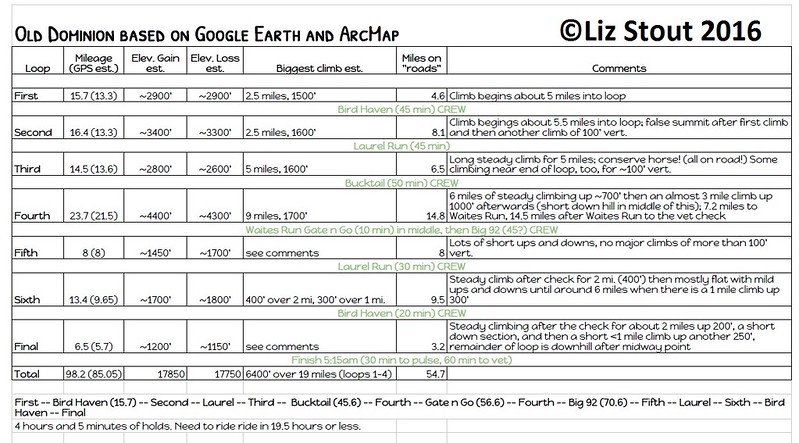 |
| Click to embiggen The hold times here are based on best guesses, GPS estimates made from personal GPS on OD 50 and No Frills along with measurements made in mapping programs |
By the time I had amassed information to develop the above table, I was quite familiar with the OD 100 course. It would be hard not to be after all of that! The result of this was that I felt more confident than I had before about being able to do this ride. The little switch in my brain that said, "Maybe do the OD 100" flipped to "Definitely do the OD 100".
My mapping showed that there were four significant climbs on the OD 100, one on each loop 1, 2, 3, and 4. Of those climbs I had completed 3 when riding the OD 50 and No Frills - the climb on loops 1, 2, and 4. The remaining climb that I had not seen/completed was a steady 6-mile climb on all gravel road. Perfect!
Beyond those climbs, the ride looked super doable for Q and I (based on our conditioning history which is outlined more in depth below). And the fact that over half of the ride would be on roads*, I knew it was well within our abilities. The absolute worst parts of the ride were things we had ridden before!
The Hard Data from My Ride as Gathered by My GPS
Now, I'd debated doing an entirely different post of just my statistics from the ride, but because of the number of hits on my ride story and the huge interest in it, I've decided to just add the statistics to this post. Putting all of the information in one place will better guarantee that seekers find what they are looking for. Additionally, I don't like the idea of someone only seeing my "best guesses" in the above table without seeing how the ride actually played out.I must note for those who don't know/realize: All GPS units have a degree of error in accuracy. The more money you spend on a GPS unit, the less error your data will have [usually]. My $120 Garmin 310XT doesn't hold a candle to a Trimble unit (that rings in to the tune of $1,500 and up!). To my best estimate, my Garmin has about a 9% error - just like my Endomondo app on my Samsung Galaxy S6.
The combination of my measurements of the trail via computer analysis with mapping programs and the actual data my GPS pulled in from the ride provide a better range of accuracy for which to judge the trail.
The results? Well, see for yourself.
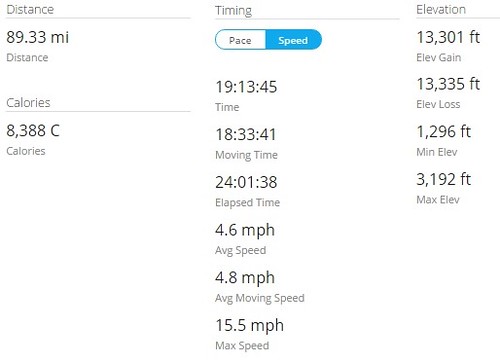 |
| I wonder about the accuracy of the calories.... |
 |
| Actual ascents on those climbs was a bit worse than estimated! Meep. (Also, forgive me if this image is glitchy, I've tried to fix it with no avail.) |
Not too far off my original estimates at all! Especially when you consider the % error with the GPS over time. Factoring that in, the new total mileage would be 97.4 miles and the total ascent would be 14,498 feet. The mileage is spot on with what the actual is supposed to be (98.2) and the vertical gain differs from my originally estimated ~17,000' by about 1,500'.
I'm really glad I spent the time doing all of this research because by the time the ride rolled around I felt very comfortable and ready. Committing most of the climbs to memory and knowing about when I would encounter them helped me stay in the game mentally and never feel like the trail got the best of me.
Reading others accounts of the ride
To supplement my mapping efforts, I also perused the interwebz for others' ride stories. You see, it's one thing to map the trail, but something else entirely to actually RIDE it. I didn't find many (and I didn't save the links to the ones I read), but I did take notes on them for my own use.I also took some time to review my past ride stories and post-ride analysis write-ups on the OD 50 and No Frills to recall the trail and time spent on each loop.
From others and my own stories, I developed the below:
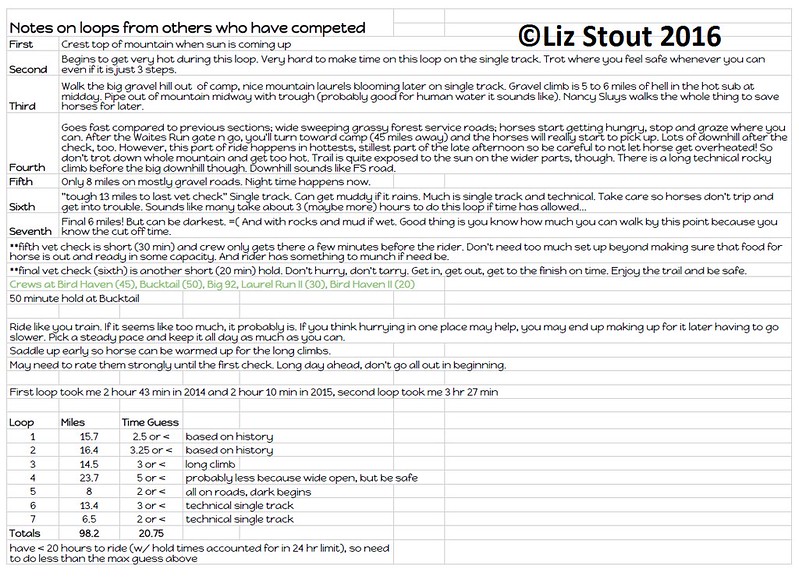 |
| Notes based on accounts of others and personal experience with OD 50 and OD 25 |
Quizzing other 100 riders
I took some time to lurk on the 100 mile riders Facebook group and also reach out to friends who have successfully completed 100(s). I sought any and all advice on completing a 100 from tips and tricks on food, gear, preventing injury, managing pain, managing soreness, etc. Anything and everything I could find out I did.Through these readings, I packed better than I would have otherwise and I definitely got amazing tips for human supplements I wouldn't have picked up!
Thanks to these conversations, I supplemented myself with BCAAs (branched chain amino acids) and took Recoverite by Hammer Nutrition as soon as the ride was over. I also ate very well during the ride (food detailed more below) and drank immensely well, too.
Supplements coupled with constant drinking and eating all day resulted in me having no major soreness at all from the ride. I was a little bit stiff the next day, but beyond a very tight left calf muscle (not the deeper soft tissues like in the past!!! YAY), I was fine! I have been way more sore after 50s before.
Well-planned fitness conditioning (for horse and rider)
Conditioning is a process for endurance. Muscle, soft tissue, and bone all condition over different lengths of time and our conditioning took place slowly over 4 years to build up to this 100 attempt. It [the 100] wasn't the grand end-goal plan necessarily, but in hindsight things played out really perfectly with our training to make it so:Year 1 - long slow distance (LSD) and getting familiar with one another. We also dabbled in jumping and anything else under the sun. Did 1 LD.
Year 2 - more LSD moving into longer rides and rides at a faster pace. Began 50s. Supplemented with some jumping and dressage-based-concept flatwork. Added the occasional hill sprint session.
Year 3 - continued pushing harder and faster on trail, added hill sprints to the regular schedule, pursued rides over lots of terrain off property. Largely focused on trails and no jumping. Also competed in 50s.
Year 4 - Trail conditioning turned into something that happened a couple times a month. These rides were usually longer than 15 miles and averaged 6-8 mph with emphasis on the faster end of that spectrum as it is faster than my race pace. We also did hill sprints regularly and began trotting downhills where footing wasn't too technical. The way things played out, we'd do a big ride, have lots of rest, then do another. Q had a lot of down time in comparison to past years and it was GREAT for her.
And then, once I really decided to do the OD 100, I took Year 4's focus and added in as much technical terrain (Dolly Sods and Canaan) as I could fit in and also added work trotting down gravel roads so Q had the opportunity to be more comfortable with that.
I also paid special attention to how much climbing we were doing on our rides. I wanted to do as much climbing as we could - and I'm so fortunate to have trails accessible from my barn and within a short trailer ride that fulfill this criteria. I knew the total vertical gain estimate for the OD 100 based on my research, so I'd do calculations after each of my rides to see, "Does 2170' of climbing from this 14 mile ride compare to the OD percentage-wise?" Well, 14% of ~17,000 is 2380' - so yes, that 14 mile ride was very comparable.
All of the above, combined with the added fact that I live in the middle of an area that is VERY similar in terrain to the OD meant that Q was fit and ready to tackle the course.
So that left ME. I had to get myself fit. And all along once I made the decision to do this ride I would tell people, "Yeah, Q's ready. I'm worried about myself!"
I spent the winter making a point to really ski my legs off when I was on the mountain for patrol. I'd do workouts on the bike trainer during the week at home. I also supplemented that with piyo workouts at home that I did 6 days a week from December 29 until the beginning of March.
The weather broke for the better in March, so my indoor workouts ceased as I got on the bike more outside. And then, April rolled around and Dave and I took a 2 week road trip that was very, very active which I treated as a fitness bootcamp of sorts for myself hiking, climbing, and biking my way across the American west. (We moved our bodies over 100 miles of terrain in that 2 week period - and drove them 5200 miles by the end of it!)
The weekend after the road trip was No Frills 55. At the end of that 55, both Q and I were feeling GREAT and I KNEW then that the 100 was well in our reach. Neither horse or rider has ever felt that perky following a 55 before. It was so awesome.
After No Frills, Q and I did a couple bigger rides and a lot of mountain sprints. Those mountain sprints (and I call them mountain instead of hill because it's a sustained, steep ascent for ¼-½ mile. The sprintable section we most often used was usually around the ¼-mile mark and sometimes was a little longer. Q fired up that slope every time like her tail was on fire until she was absolutely too beat to continue. It made her huff and puff and kept her heart rate up like nothing else we did. At the end of our sets I would always dismount and walk her down, hand feeding her grass as we went. Because despite being so hot with high respirations and HR from busting her butt on the workout, she was always super hungry which was a great thing to see.
I think those mountain sprints really cemented her fitness level into a super amazing place for the 100. They sculpted her into a beast that tackled all of the climbing on the 100 with ease - even in the heat! Which, by the way, we didn't get to train for because the ride was literally the first hot day of the summer!!
The only thing I didn't do as much of preceding this ride conditioning-wise for Q (and myself!) that I wish I'd done a little more of (and will in the future) is more dressage work. It will really benefit us both for the better. Beyond this addition though, I am 110% satisfied with our conditioning plan leading up to the OD 100!
A great farrier
I moved toward shoes last fall with hopes of finding better success with them so that I could do the OD 100. It was a totally unspoken desire at the time, but it was ultimately the driving reason for my move into shoes when I did. More on my move from boots to shoes here.As if I don't already wax and wane poetically, lauding Dan's amazing work on Q's feet to people in-person, I'm going to continue it more on here:
The man is amazing. His work is outstanding. And Q's shoe job for this ride was out of this world.
The shoes & pads went on ~2 weeks out from the ride and we did not have a single issue throughout those 100 hellaciously rocky miles. Not a nail out of place.
Q was nearly foot-perfect all day long, confident in her feet over all kinds of terrain.
I had Dan's mentor out to remove Q's shoes the week after the ride (Dan was in California leading a Sun Dance), and when Ken arrived at the barn and looked at Q's feet he told me, a little surprised I think, that they were in absolutely amazing condition and there was no reason to remove them at all. He told me he'd cut the pads out and the shoes could stay (with thin bit of pad remaining between the shoe and hoof).
Q was so foot-perfect that her shoes still had all of that life left in them following the ride. Now that is one hell of a shoe job! Dan shod Q so well that her natural movement was never impeded in any way. In fact, I think the shoeing job has increased Q's confidence over such rough terrain. That movement and confidence was HUGE when it came to finding success on this ride!
Dan is amazing. (And if you live within ~3 hours of Davis, WV, he could be your farrier, too!)
Tack and clothing choices
Tack
I can definitely say that I have finally figured out the girthing issues for Q! The mohair with ample Body Glide applied at the holds did the trick beautifully and Q had no galling, rubbing, or tenderness of her girth area following the ride at all. This success is also probably partially attributed to the new static crupper ring I rigged onto my saddle that lessened the ability of the saddle to slide forward at all.The other huge win with tack was with the custom fenders I ordered. The shin pain I had at No Frills that hurt like the dickens was NONEXISTENT for 100 miles. Booya! I had a bit of tightness in the calf muscle on my left leg, but it was totally just muscular fatigue after so much time in the saddle. It resolved in about 2 days following the ride. I'll take that!
Clothing
I wore my Kerrits Flow Rise breeches throughout the day and changed into another pair for night. Both pairs have pockets sewn on for my phone. I also wore one of my Mountain Khakis button up tech shirts for most of the day. The fabric was light and airy and wicked sweat great. I was very comfortable even when it was hot, hot, hot. (I'm a big fan of physical sun protection.)On my feet I wore Salomon Speedcross 3's which are lightweight, comfy, and have kickass traction for trail running/hiking so they were perfect when I did get off and walk (which really wasn't much at all!).
And on my head, I wore my Da Brim to really help keep the sun off my face and neck. That thing looks absurd, but damn does it really help protect me from heat/sun! That, combined with the Frogg Toggs Chilly Pad towel that Sara brought me, was really what helped me stay cool throughout the muggy hot day. (Thank god for the steady breeze, too!)
An awesome crew
Having a crew made this whole ordeal so much easier. There was a great flow to the day and I didn't stress about things at checks much at all. Q was taken care of and all I had to do was take care of myself. That was freaking amazing. Two super horse-savvy people, one up-and-coming horse savvy person, and two people who could focus on me that know me super well (mom and boyfriend) was a great combo of people to Get Things Accomplished. Also, if you looked at these people from the professional side of things, I had two RNs, a podiatrist, a licensed vet tech, and a general contractor/asst. ski patrol director. Which meant I had a lot of medical knowledge for human and horse along with the Ultimate of Ultimate MacGyver in Any Situation (home, frontcountry or backcountry). Great skillsets to combine.As I think about doing another 100, I wonder about how I'd do crew. If it was a ride where all checks were back in camp, I could probably get away without a crew because I'm a totally anal planner and could have everything setup at the trailer to get Q and I through with minimal help from anyone else. But to do the OD 100 with 6 away checks again? I'd need at least one person, and really two people to make that go smoothly. There's just so much shit to move around from place to place. Having five people was a luxury beyond luxuries and I totally doubt I'll be that lucky again!
Thought out food/drink and electrolyte choices (for horse and rider)
Overall, I'm really pleased with how things went food-wise for horse and human. The biggest thing I want to keep in mind for future rides with Q is the order and timing that she's offered her grain.Horse Food
At every hold, Q had soaked alfalfa, her mash with electrolytes, hay, and water available. If it was there, she had the option of grass, too, and we always had carrots (which I would feed her more on trail than in checks). In every past ride, Q has dove into her mashes like a champ. And leading up to the actual ride day at this ride, she was fulfilling that norm.But on ride day in the holds, she was going for the alfalfa before the mash in most cases. Alfalfa is a treat my horses only get at rides, so she was cracking out on the treat pretty hard. But at the second crewless hold, where I had sent her prepackaged grain/electrolytes and alfalfa so I could prep mash etc. there, she ate the grain first. Why? Because I didn't even pull the alfalfa out until halfway through the hold. A volunteer helped me set up her mash and I got her settled with that and she ate absolutely all of it before I ever pulled out the alfalfa.
We tried this tactic at following holds with mixed success. Q still wanted the alfalfa above all other things, and eventually I just gave in and let her have that because some food is better than no food.
I do think, in addition to hiding the alfalfa until the second half of the hold in the future, I will also wait to water her grain down at all. She does like it more when it is dry than wet, but she has such a propensity toward mild choke, that I always moisten her grain at least a little bit. If she'd dive into the dry grain with interest, it would be easy to moisten it enough to guarantee she wouldn't choke at all.
Minor tweaks in the grand scheme of things! I really don't have too much to be upset about with how everything went food-wise.
Horse Electrolytes
Leading up to the ride, I made a point of going to the barn every day the week prior to give Q a mash that had a dose of Perform 'N Win and lite salt. It was a mild pre-loading regiment, but helped her for the better, I think. Thursday and Friday in camp before the ride I witnessed Q pee 3 times (!!!) which is unheard of for her. She's always been very pee shy (she didn't pee until mile 70 at Big 92 during the ride, and then again at the finish in her pen, both times it was a great color). She drank well all day, but she's always been a good drinker since I have began giving her electrolytes.In the heat of the day, I was syringing her her electrolytes at every hold (and at the pulse-n-go). Even if she ate her mash and go the dosing of electrolytes from it, she got another syringe dose. If she wasn't eating her mashes, she got two syringe doses. (We use a ½-n-½ mixture of EnduraMax and Perform 'N Win. Additionally, I'd added a tablespoon or 2 of lite salt to her pre-mixed mashes along with a half cup of Omega Max flax.)
Human Food
I ate well all day, though I didn't eat quite as ravenously as I thought I would. What does this mean? I ate, but I didn't stuff my face like a starving ultra-athlete.Things I ate: chicken salad sandwiches, watermelon (of which Q stole a LOT of, I didn't know she liked watermelon so much! Definitely going on HER list of things for next ride lol), sushi, zesty quinoa salad, yogurt, mandarin oranges, a few kettle cooked BBQ chips, an oreo or two, some fancy chocolate Nicole brings me from Maryland, a Stella Artois, a few Cheezits, and a thing of applesauce. The chicken salad sandwiches and sushi were things I ate multiple times - two holds of sandwiches (half sandwiches, I think?) and 3 holds of sushi.
I tend to crave healthy, fresh things when it's hot and I'm exercising (obviously). I go on junk food binges from time to time, but they're few and far between when heat and exercise are involved.
Human Electrolytes
In addition to my ample eating, I stayed super hydrated throughout the day, drinking 1 - 1½ liters of water from my Osprey hydration pack each loop. And at every hold I had a bottle of gatorade with BCAAs in it. I showed Nicole at the very beginning how to mix the BCAAs into the bottle and she did a bang up job of making sure I drank the whole bottle at every hold.At the end of the ride, Nicole mixed up a bottle of Recoverite for me to drink. Even through my delirium post-ride, I very distinctly remember being given that bottle and being forcefully told to drink it. (THANK YOU, NICOLE.) I drank it. It did not taste amazing, but I drank it. And I was not very sore post-ride. (Yes!!)

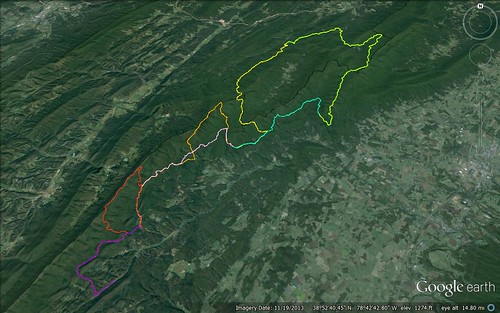
I'm still catching up on your posts as I come out of my plague-induced stupor but when I saw your beautiful map, I had to start with this one! You did such an amazing job prepping for this ride and putting together all this great information which will no doubt be beyond helpful for those who hope to follow in your footsteps! Congrats on your completion and thank you, thank you, thank you for posting so much detail!
ReplyDeleteAnd, I noted with interest your comment about giving Q dry grain instead of mash at the holds. I've noticed that Nimo will sometimes prefer dry feed to a mash, even when it's hot outside. Now that you've mentioned it, I think I might play around with wet versus dry a bit more. "Food" for thought:)
I love my map-loving friends! Mostly because it's great to meet someone who geeks out over them like I do. =)
DeleteAnd yes, food for thought indeed. I'm grateful for once that tweaking things is so simple and easy to mess around with. Makes up (a little bit) for all the times we spend too much money trying to tweak things like tack -_-
i am basically in awe of your map making and data collection. knowledge is power, right? and it seems like all your careful planning paid off big time :D
ReplyDeleteIt definitely paid off! And it was so fun to put together. My inner map geek was greatly pleased.
Delete...I feel woefully under prepared after reading this. LOL. I am taking notes on your human electrolyting and eating section...
ReplyDeleteYou've got a year to be ready for the OD100 ;-)
Delete.....good luck in the north this weekend...I think....
You were incredibly well prepared for the ride and from a crew stand point it did make life easier on us. You looked great throughout and tackled that trail like a beast. I will never be as prepared as you for anything in my life so this was really eye opening for me. I never would have even thought to map things out, but I can see how knowing the trail inside and out would really help you manage your horse and the pacing.
ReplyDeleteRegarding crewing in the future: I will come crew for you anytime as long as I can manage it so no worries there. While you could manage a 100 on your own with all holds in camp, I think having at least one person is much better for you and your horse. Being able to relax during the holds makes you less fatigued and that leads to riding better and less soreness for the horse.
Thank you <3
DeleteAnd yeah, managing Q, pace, and myself was biggest goal with the whole shebang. Definitely paid off!
I have been terribly, terribly slack in commenting lately, but I'm still reading and really loved your OD write-up and now this. Hella impressive work, lady! Thank you for sharing it.
ReplyDeleteYou live a busy life! I totally understand. I'm happy you're still finding some time to read along and are enjoying it. =) These two posts are definitely two of my more favorite I've ever been able to write on this blog!
DeleteIt's funny how (with a few tweaks) this post could be about my hubby's prep for his 100 mile run. Mapping, conditioning training, shoes, food and drink, crew. 100 miles is a lot no matter how to traverse it. Bravo for being so diligent and well prepared!!
ReplyDeleteOooh, that IS a neat comparison! I bet it is super similar. However, he's way crazier than me. Way crazier!
DeleteI love reading these sorts of ride reports. Those map making skills are impressive. The amount of prep you did totally made the day.
ReplyDeleteIt absolutely made the day! And it was so much fun to prep with so much map geekiness involved. =)
Delete